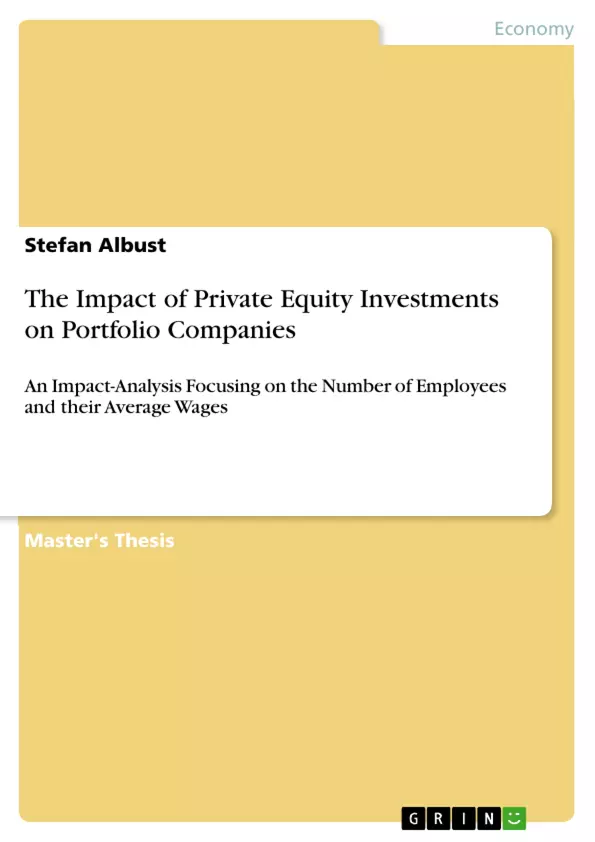This dissertation takes up the private equity topic and analyzes its impact on the employees of the portfolio companies. As there has been no detailed research done so far on the German market, this paper focuses on the impact on German companies which were taken over by a private equity house. It is assumed that the investment of a private equity company leads to an increase in the number of employees (H1) as well as their average wages (H2). These hypotheses are based on the performed literature review which shows a rather diverse picture with a slight trend towards the advantages of private equity investments.
The private equity industry is growing and therefore its importance is increasing as well. However, the reputation of private equity investors is not always positive and some harmful examples confirm this picture in the broader market. The negative history subsequently led to an increasing regulatory environment. Nevertheless, private equity financing has also many advantages for the portfolio companies such as the solution of succession concerns, additional equity financing and added external know-how.
By analyzing five private equity owned companies from different industries in Germany and benchmarking them against their local main competitor as well as testing the results against their statistical significance, interesting results appear. On the one hand, H1 needs to be rejected as in 60% of the analyzed companies the number of staff decreased after the investment of a private equity company. On the other hand, H2 can be confirmed as the average wages of the remaining employees increased in 80% of the observed companies and also evolved better compared to their non-private equity backed peers. Additionally, this dissertation shows that the second year after the takeover (T+2) is rater special and requires further investigation. Due to limitations of this research paper, it is recommended to use all the identified results for a more detailed analysis on the reasons of the observations.
Inhaltsverzeichnis (Table of Contents)
- 1. Introduction.
- 2. Literature Review.........
- 2.1. Background and History of Private Equity
- 2.2. Set-Up and Style of Private Equity
- 2.3. Motivation for Private Equity.
- 2.4. Different Views on Private Equity and the Impact on Employees..
- 3. Theory Development.
- 4. Benefit of the Study
- 5. Research Design..........\
- 5.1. Model Description..............
- 6. Findings.
- 7. Limitations
- 8. Conclusion..............
Zielsetzung und Themenschwerpunkte (Objectives and Key Themes)
This dissertation explores the impact of private equity investments on the employees of portfolio companies, particularly focusing on the German market. The research aims to assess whether private equity investments lead to an increase in the number of employees and their average wages.
- Impact of private equity investments on employee numbers.
- Effect of private equity investments on average wages.
- Analysis of the German market for private equity investments.
- Comparison of private equity owned companies with their non-private equity backed peers.
- Exploration of the impact of private equity investments in different industries.
Zusammenfassung der Kapitel (Chapter Summaries)
- Chapter 1: Introduction. This chapter sets the stage for the dissertation by providing an overview of the private equity industry and its growing significance. It also outlines the research objectives, hypotheses, and the importance of analyzing the German market.
- Chapter 2: Literature Review. This chapter delves into the existing research on private equity, covering its historical background, set-up and styles, motivations, and the different perspectives on its impact on employees. It provides a comprehensive review of the existing literature and highlights the diverse opinions regarding the effects of private equity investments.
- Chapter 3: Theory Development. This chapter elaborates on the theoretical framework underpinning the research. It outlines the key concepts and theories that inform the study, providing a foundation for the analysis.
- Chapter 4: Benefit of the Study. This chapter discusses the practical implications and benefits of the research findings for various stakeholders, such as private equity firms, portfolio companies, and policymakers.
- Chapter 5: Research Design. This chapter presents the methodology used to conduct the research. It describes the model employed for data collection and analysis, outlining the specific approach taken to investigate the impact of private equity investments.
- Chapter 6: Findings. This chapter presents the key findings of the dissertation. It discusses the results of the analysis, including the impact of private equity investments on both the number of employees and their average wages.
- Chapter 7: Limitations. This chapter acknowledges the limitations of the research, highlighting the potential constraints and areas for further investigation.
Schlüsselwörter (Keywords)
The study focuses on private equity investments, their impact on employee numbers and average wages, the German market, portfolio companies, different industries, and the comparison of private equity-backed companies with non-private equity backed peers. The research utilizes statistical analysis and empirical data to reach its conclusions.
- Citation du texte
- Stefan Albust (Auteur), 2019, The Impact of Private Equity Investments on Portfolio Companies, Munich, GRIN Verlag, https://www.grin.com/document/468448



